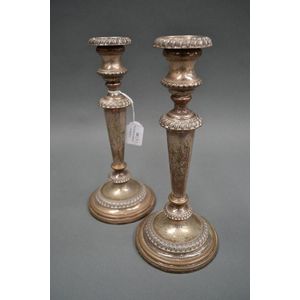French Ivory & Gilt Fawn Candlesticks by T. Blard
A pair of French 19th ivory and gilt bronze mounted candlesticks, possibly Dieppe, modelled as fawn holding grapes, signed T.Blard, 21.5 cm high
You must be a subscriber, and be logged in to view price and dealer details.
Subscribe Now to view actual auction price for this item
When you subscribe, you have the option of setting the currency in which to display prices to $Au, $US, $NZ or Stg.
This item has been sold, and the description, image and price are for reference purposes only.
- Bronze - An alloy of copper and tin, traditionally in the proportions of about 9 parts of copper to 1 part of tin.
The discovery of bronze in Western Asia in the 4th century enabled people to create metal objects which were superior to those previoulsy possible because of its strength and hardness, and it has been used throughout the world for weapons, coins, tools, statuary and other decorative items.
It is very fluid in a molten state, and its hardness, strength when set, and non-corrosive properties makes it most suitable for casting sculpture. - Ivory - Ivory is a hard white material that comes from the tusks of elephants, mammoth, walrus and boar, or from the teeth of hippopotamus and whales. The ivory from the African elephant is the most prized source of ivory. Although the mammoth is extinct, tusks are still being unearthed in Russia and offered for sale.
Ivory has been used since the earliest times as a material for sculpture of small items, both in Europe and the east, principally China and Japan.
In Asia ivory has been carved for netsuke, seals, okimono, card cases, fan supports, animals and other figures and even as carved tusks.
In the last 200 years in Europe ivory has been used to carve figures, for elaborate tankards, snuff boxes, cane handles, embroidery and sewing accessories, in jewellery and as inlay on furniture. Its more practical uses include being used for billiard balls, buttons, and a veneers on the top of piano keys.
The use and trade of elephant ivory have become controversial because they have contributed to Due to the decline in elephant populations because of the trade in ivory, the Asian elephant was placed on Appendix One of the Convention on International Trade in Endangered Species (CITES), in 1975, and in January 1990, the African elephant was similarly listed. Under Appendix One, international trade in Asian or African elephant ivory between member countries is forbidden. Unlike trade in elephant tusks, trade in mammoth tusks is legal.
Since the invention of plastics, there have been many attempts to create an artificial ivory
This item has been included into following indexes:
- ivory, Western
- sculpture - other 692
Visually similar items

An impressive pair of reconstituted stone campagna form garden urns, 127 cm high, 85 cm diameter
Sold by
in
for
You can display prices in $Au, $US, $NZ or Stg.

Pair of antique silver plated Georgian candlesticks standing 20 cm high (2)
Sold by
in
for
You can display prices in $Au, $US, $NZ or Stg.

Pair of antique French bell metal candlesticks 21.5 cm high
Sold by
in
for
You can display prices in $Au, $US, $NZ or Stg.

Pair of antique Sheffield plate Georgian candlesticks, approx. height 28 cm (2)
Sold by
in
for
You can display prices in $Au, $US, $NZ or Stg.
